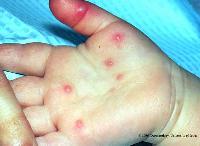
Strep throat is very common among kids and teens. Symptoms of strep throat include fever, stomach pain, and red, swollen tonsils.
Strep throat usually requires treatment with antibiotics. With the proper medical care — along with plenty of rest and fluids — your child should be back to school and play within a few days.
How Strep Throat Spreads
Anybody can get strep throat, but it's most common in school-age kids and teens. These infections occur most often during the school year when big groups of kids and teens are in close quarters.
The bacteria that cause strep throat (group A streptococcus) tend to hang out in the nose and throat, so normal activities like sneezing, coughing, or shaking hands can easily spread infection from one person to another.
That's why it's so important to teach kids the importance of hand washing — good hygiene can lessen their chances of getting contagious diseases like strep throat.
Strep Throat vs. Sore Throat
Not all sore throats are strep throats. Most episodes of sore throat — which can be accompanied by a runny nose, cough, hoarseness, and red eyes — are caused by viruses and usually clear up on their own without medical treatment.
A child with strep throat will start to develop other symptoms within about 3 days, such as:
- red and white patches in the throat
- difficulty swallowing
- tender or swollen glands (lymph nodes) in the neck
- red and enlarged tonsils
- headache
- lower stomach pain
- fever
- general discomfort, uneasiness, or ill feeling
- loss of appetite and nausea
- rash
Diagnosis
If your child has a sore throat and other strep throat symptoms, call your doctor. The doctor will likely do a rapid strep test in the office, using a cotton swab to take a sample of the fluids at the back of the throat. The test only takes about 5 minutes.
If it's positive, your child has strep throat. If it's negative, the doctor will send a sample to a lab for a throat culture. The results are usually available within a few days.
Treatment
In most cases, doctors prescribe about 10 days of antibiotic medication to treat strep throat. Within about 24 hours after starting on antibiotics, your child will probably no longer have a fever and won't be contagious. By the second or third day after taking antibiotics, the other symptoms should start to go away, too.
Even if your child feels better, he or she should finish the antibiotics as prescribed. If your child stops taking antibiotics too soon, bacteria can remain in the throat and the symptoms can return.
If your child is not treated for strep throat, he or she is most infectious when the symptoms are the most severe but could remain contagious for up to 21 days. Lack of treatment — or not finishing the prescribed course of antibiotics — also could put your child at risk for other health problems, such as rheumatic fever (which can cause permanent damage to the heart), scarlet fever, blood infections, or kidney disease.
To prevent your sick child from spreading strep throat to others in your home, keep his or her eating utensils, dishes, and drinking glasses separate from those that everyone else is using. Wash them in hot, soapy water after each use. Also, make sure your child doesn't share food, drinks, napkins, handkerchiefs, or towels with other family members.
Make sure your child covers his or her mouth and nose during a sneeze or a cough to prevent passing infectious fluid droplets to someone else. Also, throw out your child's toothbrush after the antibiotic treatment has been started and he or she is no longer contagious, and make sure your child uses a new one.
Caring for Your Child
You can help your child feel better while battling strep throat. Provide plenty of liquids to prevent dehydration, such as water or ginger ale, especially if he or she has had a fever. Avoid orange juice, grapefruit juice, lemonade, or other acidic beverages that can irritate a sore throat. Warm liquids like soups, sweetened tea, or hot chocolate can be soothing.
As recovery progresses, talk to your doctor about when your child can return to school and other routine activities.



 Yersiniosis is a relatively uncommon infection contracted through the consumption of undercooked meat products, unpasteurized milk, or water contaminated by the bacteria.
Yersiniosis is a relatively uncommon infection contracted through the consumption of undercooked meat products, unpasteurized milk, or water contaminated by the bacteria.